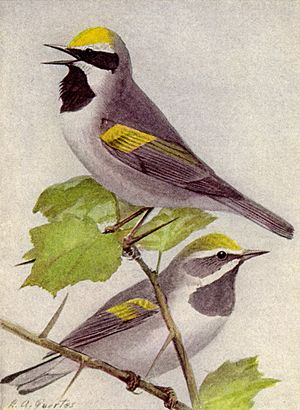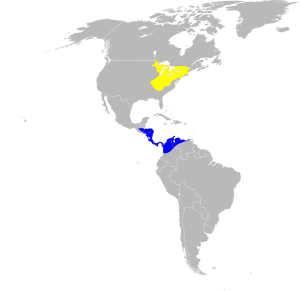Golden-winged warbler facts for kids
Quick facts for kids Golden-winged warbler |
|
|---|---|
 |
|
| Male above, female below | |
| Conservation status | |
| Scientific classification | |
| Genus: |
Vermivora
|
| Species: |
chrysoptera
|
 |
|
| Range of V. chrysoptera Breeding range Wintering range | |
| Synonyms | |
|
|
The golden-winged warbler (Vermivora chrysoptera) is a small, colorful New World warbler. These birds are known for their bright yellow wing patches. They breed in parts of southeastern and south-central Canada. They also live in the Appalachian Mountains in the eastern United States.
Most of these warblers (about 70%) breed in Wisconsin, Minnesota, and Manitoba. While their numbers are slowly growing in the north, their overall population is shrinking. This is mainly due to losing their homes. They also face challenges from a close relative, the blue-winged warbler. Sometimes, these two species compete or even interbreed.
Contents
What's in a Name?
The scientific name for the golden-winged warbler is Vermivora chrysoptera. The first part, Vermivora, comes from Latin. Vermis means "worm" and vorare means "to devour". So, it means "worm eater".
The second part, chrysoptera, comes from Ancient Greek. Khrusos means "gold" and pteron means "wing". This perfectly describes their golden wing patches!
Golden-winged Warbler Appearance
This is a small songbird. It measures about 11.6 cm (4.6 in) long. It weighs only 8–10 g (0.28–0.35 oz), which is less than half an ounce! Its wingspan can reach up to 20 cm (about 8 inches).
Male golden-winged warblers are quite striking. They have a black throat and a black patch around their ears. These black areas are outlined in white. They also have a bright yellow crown (top of the head) and a yellow patch on their wings.
Female golden-winged warblers look similar to males. However, their throat and ear patches are light gray instead of black. Both male and female birds have a lot of white on their tail feathers. You can easily see this white when they fly. Their undersides are grayish-white, and their beak is long and thin.
One interesting fact is that young golden-winged warblers can be identified as male or female. This can happen about 15 days after they leave the nest. Scientists look at the color of their throat patch to tell them apart.
Life Cycle and Habits
Golden-winged warblers are migratory birds. This means they travel long distances each year. They spend their breeding season in eastern North America. When winter arrives, they fly south. Their winter homes are in southern Central America and nearby parts of Colombia, Venezuela, and Ecuador.
Reproduction and Nesting
During the breeding season, golden-winged warblers look for specific places to build their nests. They prefer open, scrubby areas and wetlands. They also like mature forests that are close to these habitats.
Female warblers lay 3 to 6 eggs, but usually 5. They build a hidden, cup-shaped nest. This nest is often placed on the ground or low in a bush. This helps keep the eggs and chicks safe.
What They Eat
Golden-winged warblers mainly eat insects, spiders, and caterpillars. They have strong muscles around their beak. This allows them to open their beaks wide and find hidden caterpillars.
Songs and Calls
Their song can vary, but it often sounds like a trilled bzzzzzzz buzz buzz buzz. Their call is a short, buzzy chip or zip.
Bird Communication
Male golden-winged warblers use their bright yellow crowns, black throats, and white tail feathers to show off. These colorful features signal how good their territory is. Birds with brighter colors often have better territories. They also tend to be less aggressive than males with less colorful features.
However, having brighter colors doesn't always mean they have more baby birds. This might be because less colorful warblers make up for it by being more aggressive.
Avoiding Storms
In April 2014, scientists tracked five golden-winged warblers in Tennessee. They observed something amazing! These birds flew hundreds of miles south, seemingly to avoid strong tornadic storms. They left before the storm even arrived. Scientists think the birds might have detected the storm using infrasound. This is a type of sound wave that humans cannot hear.
Where They Live: Habitat Selection
Golden-winged warblers are birds that migrate between the tropics and North America. Their choice of habitat changes with the seasons.
When they spend the winter in Costa Rica, they choose evergreen forests in the mountains. They prefer these over drier tropical forests. They often look for food in hanging dead leaves. These leaves are usually found in forests that have had some small disturbances.
During the breeding season, golden-winged warblers nest in shrublands. They also use young forests that are growing back after a disturbance. This need for specific, early-stage habitats is one reason their populations are declining.
Hybrid Birds
Where golden-winged warblers and blue-winged warblers live in the same areas, they sometimes have mixed-species offspring. This is called hybridization. This happens in the Great Lakes and New England regions.
Brewster's Warbler
The more common hybrid is called Brewster's warbler. It is gray on its back and whitish on its belly (for males) or yellow on its belly (for females). It has a black stripe across its eye and two white bars on its wings.
Lawrence's Warbler
The rarer hybrid is called Lawrence's warbler. Male Lawrence's warblers have green and yellow on their back and yellow on their belly. They have white wing bars and the same face pattern as a male golden-winged warbler. Female Lawrence's warblers are gray on their back and whitish on their belly. They have two yellow wing bars and the same face pattern as a female golden-winged warbler.
Burket's Warbler
Another very rare hybrid is the Burket's warbler. It has been seen in the same areas as Brewster's and Lawrence's warblers. Researchers at Cornell University's Lab of Ornithology first recorded this bird.
Brewster's, Lawrence's, and Burket's warblers can look quite different from each other. They might also sing songs that sound like either blue-winged or golden-winged warblers.
Scientists now believe that hybridization between these two species is happening more often than previously thought. Genetic studies have shown that sometimes, a female golden-winged warbler might have chicks with a male blue-winged warbler. This can result in chicks that look like golden-winged warblers but are actually hybrids.
Other Bird Interactions
In 2015, scientists saw a very unusual event. A female golden-winged warbler left her two young chicks. They were only 5 and 9 days old. A male black-and-white warbler then "adopted" these two chicks. He fed them for 23 days until they were old enough to be on their own.
Images for kids
See also
 In Spanish: Chipe alidorado para niños
In Spanish: Chipe alidorado para niños







